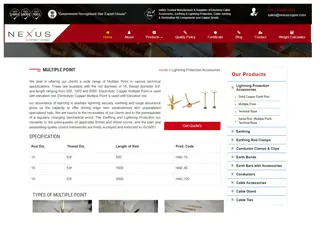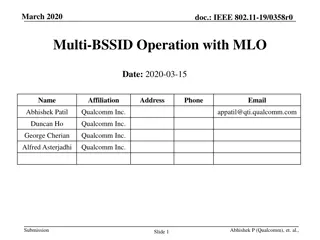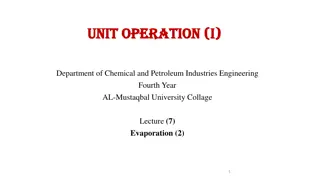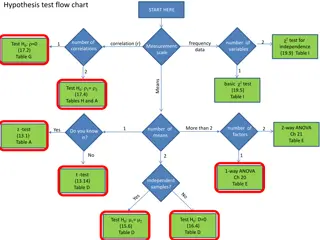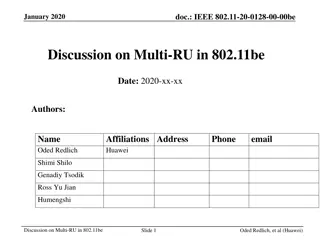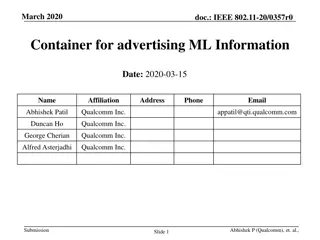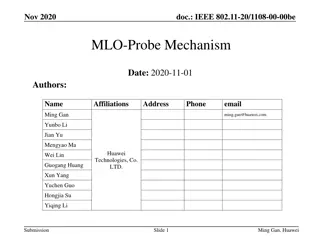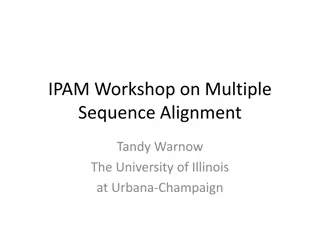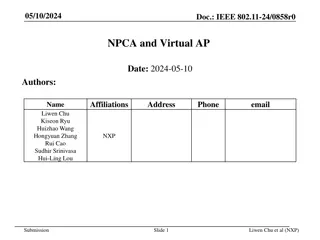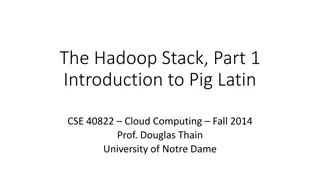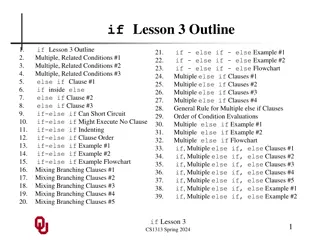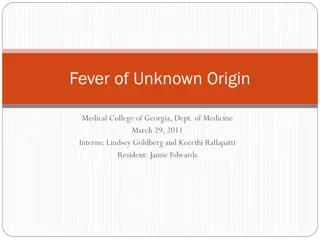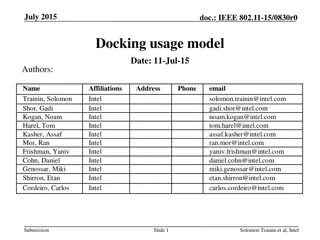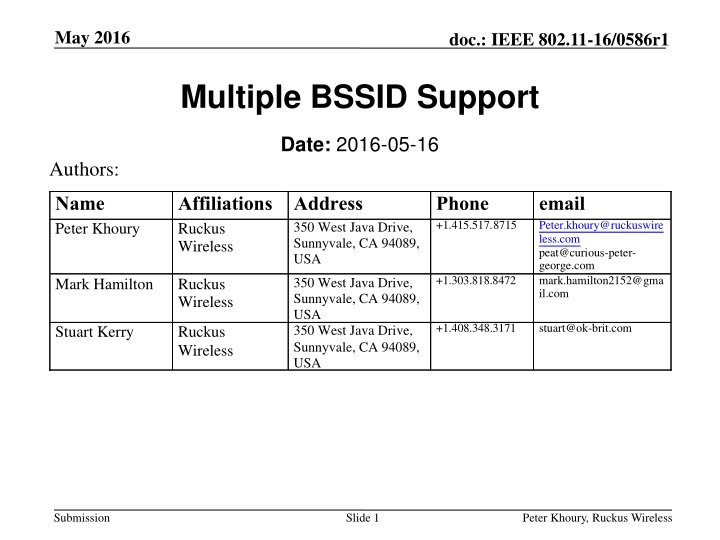
Supporting Multiple BSSID in High Density WiFi Environments
Discover how supporting multiple BSSID can reduce management overhead in high-density WiFi setups, as discussed in the IEEE document by Peter Khoury from Ruckus Wireless. The analysis of a high-density stadium environment showcases the impact on airtime utilization and the necessity of limiting multiple SSIDs broadcasted by every physical AP for optimal performance.
Download Presentation

Please find below an Image/Link to download the presentation.
The content on the website is provided AS IS for your information and personal use only. It may not be sold, licensed, or shared on other websites without obtaining consent from the author. If you encounter any issues during the download, it is possible that the publisher has removed the file from their server.
You are allowed to download the files provided on this website for personal or commercial use, subject to the condition that they are used lawfully. All files are the property of their respective owners.
The content on the website is provided AS IS for your information and personal use only. It may not be sold, licensed, or shared on other websites without obtaining consent from the author.
E N D
Presentation Transcript
May 2016 doc.: IEEE 802.11-16/0586r1 Multiple BSSID Support Date: 2016-05-16 Authors: Name Peter Khoury Affiliations Address Ruckus Wireless Phone +1.415.517.8715 email Peter.khoury@ruckuswire less.com peat@curious-peter- george.com mark.hamilton2152@gma il.com 350 West Java Drive, Sunnyvale, CA 94089, USA +1.303.818.8472 350 West Java Drive, Sunnyvale, CA 94089, USA 350 West Java Drive, Sunnyvale, CA 94089, USA Mark Hamilton Ruckus Wireless +1.408.348.3171 stuart@ok-brit.com Stuart Kerry Ruckus Wireless Submission Slide 1 Peter Khoury, Ruckus Wireless
May 2016 doc.: IEEE 802.11-16/0586r1 Abstract Support of Multiple BSSID information element will contribute substantially to reducing management overhead. Because this feature can be used in Probe Responses, these savings accrue even when only some of the network clients support this feature. This gives an opportunity for introduction of a feature that is universally beneficial. Submission Slide 2 Peter Khoury, Ruckus Wireless
May 2016 doc.: IEEE 802.11-16/0586r1 Characterization of Rio Tinto Stadium Environment Salt Lake City Soccer Stadium ~80APs in bowl ~105APs total (for concessions and infrastructure) ~20k seat capacity Full during testing -> ~10k clients We analyze WiFi data sniffed in this environment and take it to be representative of a High Density WiFi installation. Submission Slide 3 Peter Khoury, Ruckus Wireless
May 2016 doc.: IEEE 802.11-16/0586r1 Airtime Utilization in High Density Environment Management Traffic can consume substantial amounts of airtime. Beacons up to 8-9% Probe Responses up to 9- 10% Probe Requests - % Utilization depends on AP placement APs placed in the center of the stadium hear more clients and other APs. Submission Slide 4 Peter Khoury, Ruckus Wireless
May 2016 doc.: IEEE 802.11-16/0586r1 Multiple SSIDs on every AP Many deployed networks have Multiple SSIDs broadcast by every physical AP. This stadium had five SSIDs. Must compromise convenience of multiple SSIDs for performance. During every HD installation Ruckus engineers must advocate and explain the necessity of limiting the number of SSIDs. Ideally only one SSID would be used which oftentimes is not ideal for network management. Neutral host APs will require more SSIDs which exacerbates this problem. One SSID will be needed per provider. Submission Slide 5 Peter Khoury, Ruckus Wireless
May 2016 doc.: IEEE 802.11-16/0586r1 Multiple SSIDs on every AP With multiple SSIDs multiple Beacons and Probe Responses must be transmitted which wastes access time and airtime. Illustration of waste and potential savings for Probe Responses. Client Active Channel Scan Behavior Current Broadcast Probe Probe Rsp AP2 Probe Rsp AP1 Probe Rsp AP1 Probe Rsp AP1 Probe Rsp AP2 Probe Rsp AP2 AP1 Request SSID_A SSID_C SSID_C SSID_A SSID_B SSID_B AP2 Consolodate Consolodate Client Multiple Support BSSID SSID_A, SSID_B, SSID_A, SSID_B, Broadcast Probe Probe Rsp AP1 Probe Rsp AP2 With AP1 & SSID_C & SSID_C Request AP2 Submission Slide 6 Peter Khoury, Ruckus Wireless
May 2016 doc.: IEEE 802.11-16/0586r1 Multiple BSSID Airtime Savings The diagrams below show standard broadcast probe request response behavior above the proposed broadcast probe request behavior. All of the time indicated in light gray is saved when the network can make use of the multiple BSSID feature. The savings can be broken into two components. Access Time Transmission Time Submission Slide 7 Peter Khoury, Ruckus Wireless
May 2016 doc.: IEEE 802.11-16/0586r1 AccessTime Benefits For management frames CWmin might be set to 2 or 3 which corresponds to 4 to 8 slots. In this case 36us to 72us are consumed per medium access. A network having 5 SSIDs in which a broadcast probe request is heard by 5 APs will need to access the airtime 25 times. With implementation of the multiple BSSID feature only 5 accesses would be necessary providing a savings of 720us to 1.4ms. The above calculations are conservative assuming no other devices contending for the network and no chance of collision. Submission Slide 8 Peter Khoury, Ruckus Wireless
January 2016 doc.: IEEE 802.11-16/0586r1 AccessTime Benefits Cont. In a congested network these numbers can become much worse. CWmin should increase in a congested network Collisions require rebroadcast of packets Management packets contending for airtime preempt desirable useful data packets. Implementation of the Multiple BSSID feature can dramatically reduce the number of management packets contending for the medium. This allows for greater transmission of useful data with less latency. Submission Slide 9 Peter Khoury, Ruckus Wireless
January 2016 doc.: IEEE 802.11-16/0586r1 Time Savings for Probe Response in a Network with 5 SSIDs Without Multiple BSSIDs With Multiple BSSIDs Octets in Field Repetition s Total Octets Octets in Field Field Repetitions Total Octets 3 Address Header w/o BSSID 18 5 90 18 1 18 BSSID 6 5 30 8 5 40 Fixed Params (time & interval) 10 5 50 10 1 12 Fixed params (capabilities) 2 5 10 4 5 20 SSID 9 5 45 9 5 45 Supported Rates 6 5 30 6 1 6 DS Param Set 3 5 15 3 1 3 Country Info 18 5 90 18 1 18 ERP Info 3 5 15 3 1 3 Extended Supported Rates 10 5 50 10 1 10 WMM/WME 26 5 130 26 5 130 HT Capabilities 28 5 140 28 1 28 HT Information 24 5 120 24 1 24 Total 163 815 357 Submission Slide 10 Peter Khoury, Ruckus Wireless
May 2016 doc.: IEEE 802.11-16/0586r1 Multiple BSSID Packet Time Savings 5 SSID s in Stadium Environment Current Probe Response Transmission 163 octet payload at 12Mbs takes 132us Repeated 5 times takes 660us Proposed Probe Response Transmission 357 octet payload at 12Mbs takes 260us Only transmitted once Savings of 400ms or 61% savings Effect in Rio Tinto Currently 9% of Network Airtime Consumed by Probe Responses Becomes only 3.5% of Network Airtime Submission Slide 11 Peter Khoury, Ruckus Wireless
May 2016 doc.: IEEE 802.11-16/0586r1 Multiple BSSID Total Savings Probe Response Access Time drops from 900us to 180us saving 720us Probe Response Transmission Time drops from 660us to 260us saving 220us Total savings 1560us to 440us saving 1120us 72% improvement from the current 9-10% airtime consumed Submission Slide 12 Peter Khoury, Ruckus Wireless
May 2016 doc.: IEEE 802.11-16/0586r1 Summary The implementation of the straight-forward Multiple BSSID mechanism can produce real immediate savings in existing high density networks. Additionally mandating this feature now will start the process of getting it implemented in clients allowing future networks to achieve additional savings by allowing Beacons make use of the feature. Submission Slide 13 Peter Khoury, Ruckus Wireless

